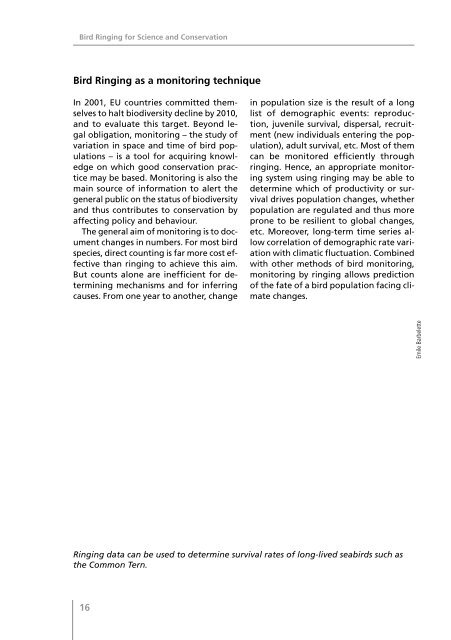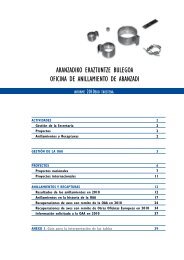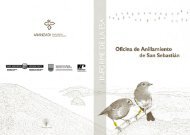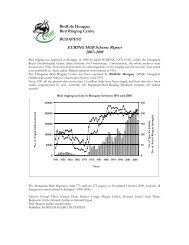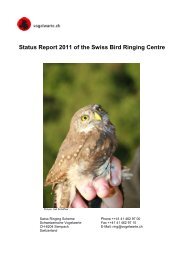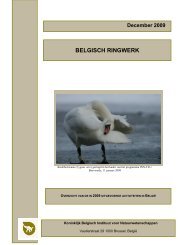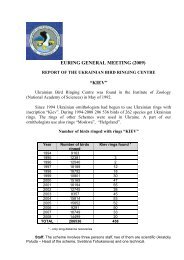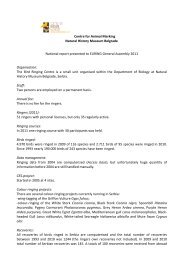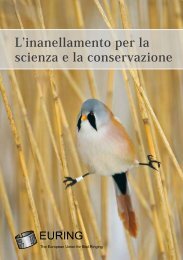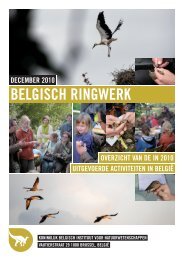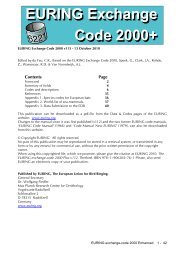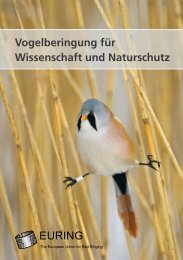Bird Ringing for Science and Conservation - The European Union ...
Bird Ringing for Science and Conservation - The European Union ...
Bird Ringing for Science and Conservation - The European Union ...
- No tags were found...
Create successful ePaper yourself
Turn your PDF publications into a flip-book with our unique Google optimized e-Paper software.
<strong>Bird</strong> <strong>Ringing</strong> <strong>for</strong> <strong>Science</strong> <strong>and</strong> <strong>Conservation</strong><br />
<strong>Bird</strong> <strong>Ringing</strong> <strong>for</strong> <strong>Science</strong> <strong>and</strong> <strong>Conservation</strong><br />
<strong>Bird</strong> <strong>Ringing</strong> as a monitoring technique<br />
In 2001, EU countries committed themselves<br />
to halt biodiversity decline by 2010,<br />
<strong>and</strong> to evaluate this target. Beyond legal<br />
obligation, monitoring – the study of<br />
variation in space <strong>and</strong> time of bird populations<br />
– is a tool <strong>for</strong> acquiring knowledge<br />
on which good conservation practice<br />
may be based. Monitoring is also the<br />
main source of in<strong>for</strong>mation to alert the<br />
general public on the status of bio diversity<br />
<strong>and</strong> thus contributes to con servation by<br />
affecting policy <strong>and</strong> behav iour.<br />
<strong>The</strong> general aim of monitoring is to document<br />
changes in numbers. For most bird<br />
species, direct counting is far more cost effective<br />
than ringing to achieve this aim.<br />
But counts alone are inefficient <strong>for</strong> determining<br />
mechanisms <strong>and</strong> <strong>for</strong> inferring<br />
causes. From one year to another, change<br />
in population size is the result of a long<br />
list of demographic events: reproduction,<br />
juvenile survival, dispersal, recruitment<br />
(new individuals entering the population),<br />
adult survival, etc. Most of them<br />
can be monitored efficiently through<br />
ringing. Hence, an appropriate monitoring<br />
system using ringing may be able to<br />
determine which of productivity or survival<br />
drives population changes, whether<br />
population are regulated <strong>and</strong> thus more<br />
prone to be resilient to global changes,<br />
etc. Moreover, long-term time series allow<br />
correlation of demographic rate variation<br />
with climatic fluctuation. Combined<br />
with other methods of bird monitoring,<br />
monitoring by ringing allows prediction<br />
of the fate of a bird population facing climate<br />
changes.<br />
<strong>Ringing</strong> data can be used to determine survival rates of long-lived seabirds such as<br />
the Common Tern.<br />
Emile Barbelette<br />
Matthias Kestenholz<br />
Great Tits easily<br />
accept to breed in<br />
nest-boxes which<br />
renders them accessible<br />
<strong>for</strong> ringing.<br />
Hundreds of<br />
thous<strong>and</strong>s have<br />
been ringed <strong>for</strong><br />
long-term population<br />
studies that<br />
provided fundamental<br />
insights<br />
into evolutionary<br />
processes, population<br />
dynamics,<br />
breeding biology<br />
<strong>and</strong> behavioural<br />
ecology.<br />
Monitoring through ringing may either<br />
rely on intensive co-ordinated schemes or<br />
be the outcome of the accumulation of<br />
long-term database. <strong>The</strong> <strong>for</strong>mer is best<br />
illustrated by the “Constant Ef<strong>for</strong>t Site”<br />
scheme (CES; also known as “Monitoring<br />
Avian Productivity <strong>and</strong> Survival” in<br />
North America, an acronym that speaks<br />
<strong>for</strong> itself). Initiated in 1983 in the UK <strong>and</strong><br />
Irel<strong>and</strong>, CES is currently organised in 16<br />
EU countries, on 600 sites where over<br />
100,000 birds are caught annually. CES is<br />
unique in producing annual indices of reproductive<br />
success of more than 30 species<br />
throughout Europe. CES data have,<br />
<strong>for</strong> example , shown that hot weather in<br />
spring was negatively affecting productivity<br />
of already declining species. This suggests<br />
a link between climate warming <strong>and</strong><br />
long term population trend through reproductive<br />
success <strong>for</strong> a large number of<br />
species. <strong>The</strong> production of annual indices<br />
of productivity at a <strong>European</strong> scale is under<br />
study <strong>and</strong> is likely to be achievable<br />
in the near future. <strong>The</strong> long term ringing<br />
database is also most useful to monitor<br />
changes, through time, of key demographic<br />
parameters of bird population.<br />
Among them, changes in migration route,<br />
migration timing <strong>and</strong> migration probabilities<br />
are the most evident. Last but nor<br />
least, one of the few globally threatened<br />
bird species <strong>for</strong> which Europe has the main<br />
responsibility, the Aquatic Warbler, is almost<br />
entirely monitored through ringing,<br />
allowing us to determine the stability of<br />
the stopping-over network from Western<br />
Russia <strong>and</strong> Pol<strong>and</strong> to Spain.<br />
<strong>The</strong> most useful monitoring schemes<br />
are those that cover a large scale <strong>and</strong> that<br />
may be run in the long term. Although<br />
CES is showing the way, there is considerable<br />
room <strong>for</strong> improving the efficiency of<br />
monitoring by ringing. Another direction<br />
of improvement is the continuous integration<br />
of different monitoring schemes.<br />
This means more organisation <strong>and</strong> support<br />
<strong>for</strong> the volunteers who make up the<br />
only network able to monitor biodiversity<br />
throughout Europe. This is achievable by<br />
encouraging scientists to work in close association<br />
with ringing schemes.<br />
16<br />
17


